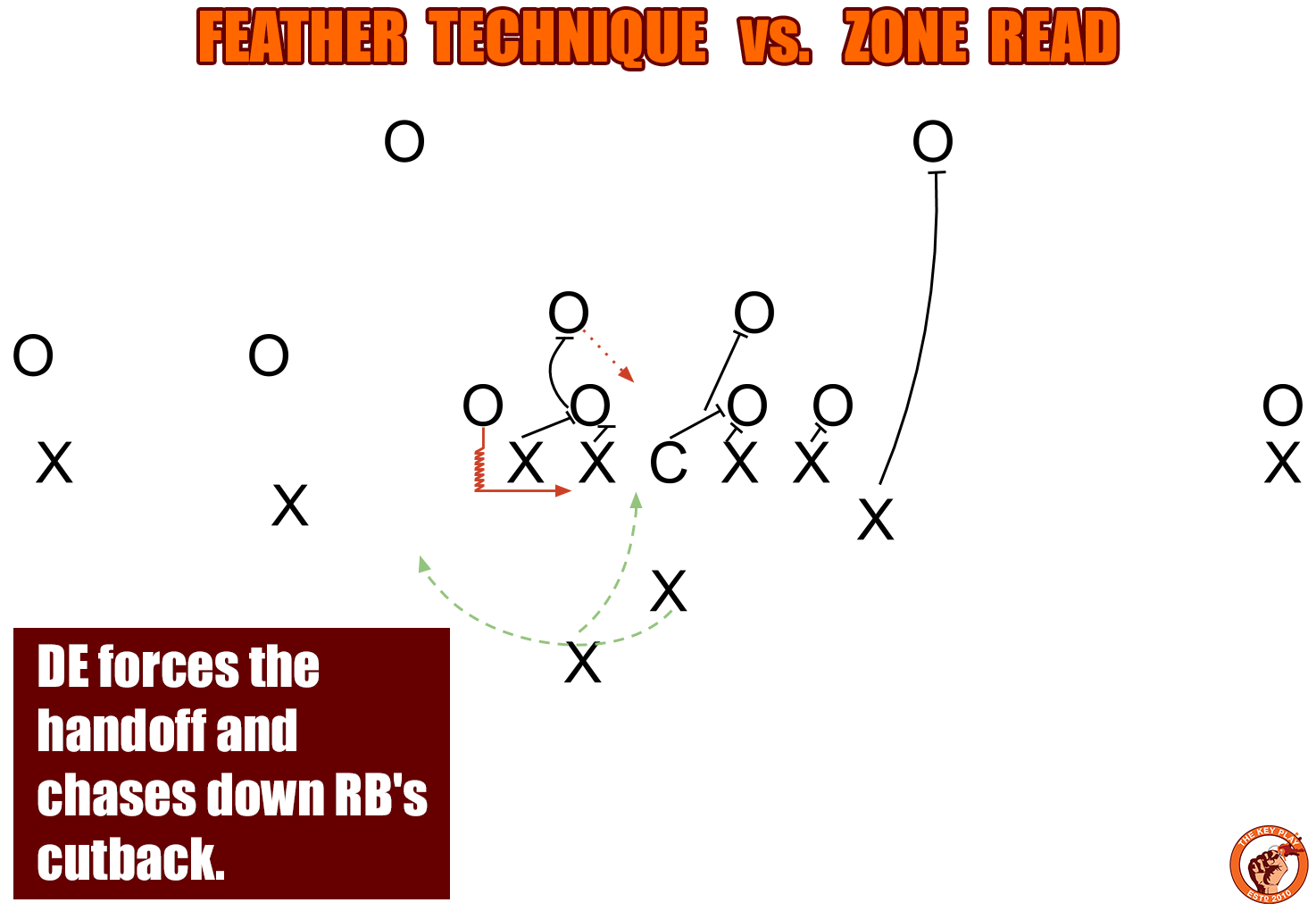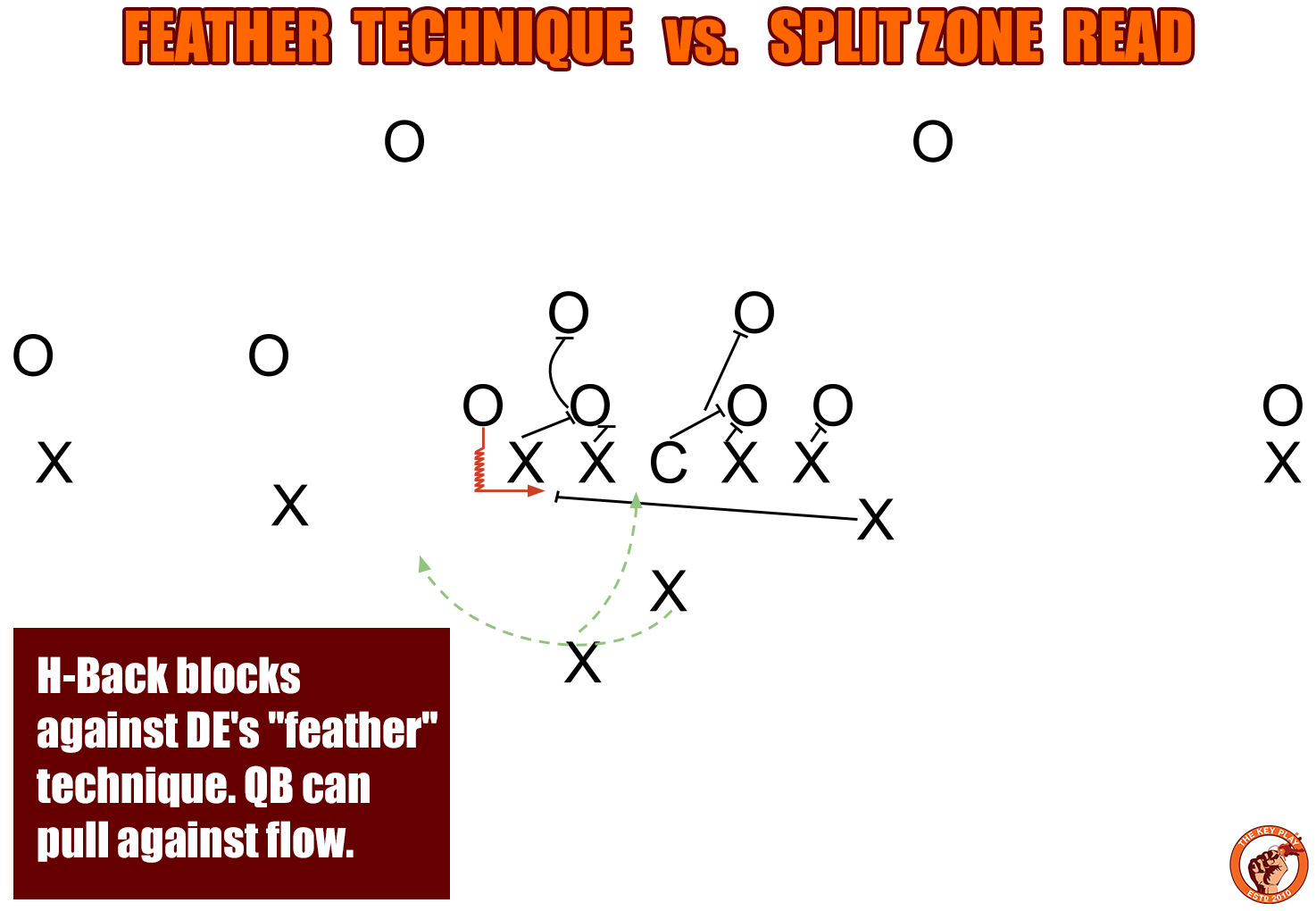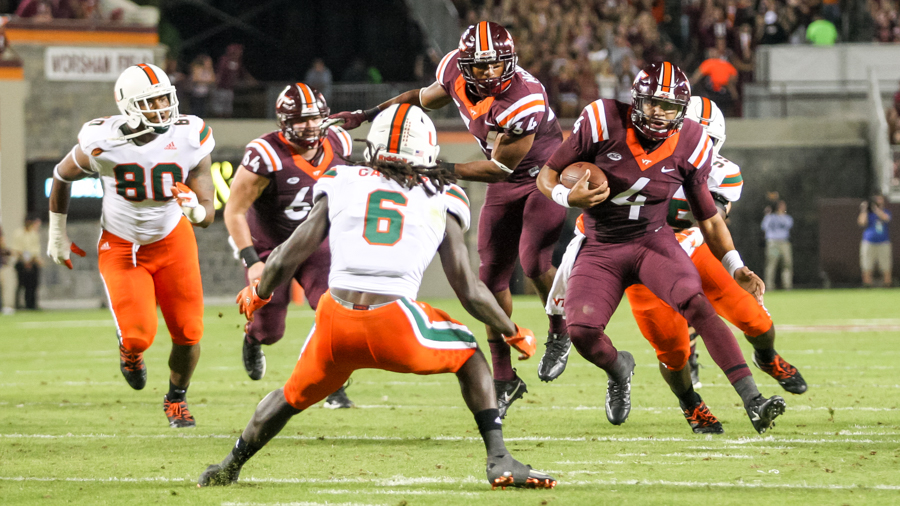Virginia Tech quarterback Jerod Evans led the Hokies in rushing yards (846), attempts (204), and scores (12) last season. It should be obvious after Justin Fuente's 14 initial games as Tech's head coach that the QB is not a bystander in his ground attack.
As a refresher, Fuente's offensive strategy is an inherently conservative one. He incorporates a wide variety of blocking schemes in his rushing attack to capitalize on the easy yardage defenses are willing to concede, and to make it difficult for defenses to scheme against the offense and create negative plays. Let's examine how Fuente gets the QB involved in the rushing attack, and how that furthers his conservative strategy.
The Zone Read
Fuente gains a numerical advantage against defenses by employing his quarterback as a ball carrier. The defense has to account for all 11 players on the field when the quarterback is a running threat, a concern defenders don't have against pro-style offenses. The Zone Read is an easy way to take a defender out of the play by having the quarterback read an unblocked player. Rich Rodriguez made his name by exploiting defenses that had aggressive back-side pursuits by developing the Zone Read. With this play, a back-side defender, who the quarterback reads, is left unblocked. If the defender pursues down the line of scrimmage towards the running back, the quarterback pulls the football and keeps, otherwise he gives to the running back.
Prior to the 2016 season, French did an excellent job analyzing how Fuente used the Zone Read while he was at Memphis. Surprisingly, while rewatching last season's games, I didn't see as much pure Zone Read as I expected. Instead, Fuente used a Split Zone approach to slow down back-side pursuit. Split Zone refers to a running play where the offensive line zone blocks in one direction while one player (an H-Back in Tech's offense) comes across the formation and tries to block back-side pursuit.
The H-Back's blocking assignment can change on a Split Zone Read depending on how the defense is defending the Zone Read. Conservative defensive coordinators try to keep two high safeties against the Zone Read by asking their back-side defensive end to slow play the mesh, commonly called a "feather" technique. The other defenders commit to the run straight away, hoping to make a tackle or force the running back to cut back. This gives an athletic defensive end the time to force a handoff and then chase the running back down. This is exactly what Notre Dame tries to do in the play above.
Both Irish linebackers stay home to protect their interior gap responsibilities. Tech's entire offensive line uses an inside zone blocking technique by protecting their play-side gap (gap to its right). Sam Rogers is aligned as the H-Back and cuts back against the grain to kick out defensive end Isaac Rochell (No. 90). Rochell tries to slow play ("feather") the mesh in order to force Evans to hand the ball off to running back Steven Peoples. Peoples would have nowhere to go. Instead, Rogers' kick out block ties up Rochell long enough for Evans to get on the perimeter and find the end zone.
The Split Zone Read is an effective counter for the "feather" technique because it puts the defensive end in no man's land.


If the DE stays at home and forces a hand off, the H-Back's kick out block prevents him from chasing down the line, and it gives the offense a numerical advantage. If the DE attacks the H-Back's block and tries to help tackle the running back, the QB can pull the ball and then the only defender in the vicinity is a safety ten-or-more yards down the field.
The other way defensive coordinators try and defeat the Zone Read is by utilizing a scrape exchange. A scrape exchange is when an unblocked defensive end immediately crashes down the line to tackle the running back. Simultaneously, another back-side defender (either linebacker or safety) "scrapes" over the top towards the back-side to tackle the QB. Ideally, for the defense, the quarterback quickly pulls the ball from his running back only to be meet with a hard charging linebacker in position to make a play. With a slight tweak to the H-Back's responsibilities, the Split Zone Read can be the perfect adjustment to defeat a scrape exchange.
The beginning of this Evans' touchdown run is almost identical to the aforementioned one. The Hokies' offensive line utilizes inside zone blocking while Rogers, again aligned as an H-Back, cuts against the grain and heads towards the back-side. This time however, the defensive end — Pat Bethel, No. 93 — ignores Evans and crashes hard down the line to tackle Marshawn Williams. Things go poorly for Miami when Rogers runs past Bethel and looks for a scraping defender to block on the perimeter. It is unclear if Miami's corner (No. 12) or safety (No. 6) is responsible for scraping and taking on Evans, but eventually the corner arrives to try and make a play. Rogers influences the corner long enough for Evans to fly past him en route to a house call.
The H-Back's involvement in the Split Zone Read provides a numerical advantage that defensive coordinators can't scheme away. Defenses have to get more defenders in the box if they want to prevent the offense from staying ahead of the chains. In order to press this advantage, and to get the most out of his mobile quarterbacks, Fuente relies on more than just the Zone Read and its variations.
Quarterback Power And The Option Game
It is no coincidence that the quarterbacks who do well in Fuente's system have a similar physical build. While the Zone Read and Split Zone Read attack the defense on the perimeter, Fuente likes to use powerful quarterbacks in the interior run game. These larger quarterbacks not only have the ability to move the pile and win in vital short yardage situations, but they also have the physical tools to withstand the consistent pounding a runner takes on the inside.
The clip above is an Inverted Veer. It's a play Fuente is largely credited with devising while offensive coordinator at TCU, and it is one of the hardest plays to stop in modern college football. It's almost impossible to defend without elite athletes on the defensive line because of the threats of outside and inside runs paired with a large number of blockers at the point of attack. The QB reads an unblocked play-side defender, usually a defensive end (unlike the Zone Read which is a back-side read). If the end defends against the jet sweep, the quarterback keeps the ball and runs inside. If the end gets upfield to take away the quarterback run, the quarterback hands the ball off to a speedy back or receiver who can get to the perimeter and try to turn up field.
Also notice how Fuente has moved right tackle Jonathan McLaughlin from the right side of the formation to the left to yield an unbalanced line. This moves Evans' read even further outside, which not only makes the read easier to diagnose, but it also gives him an extra blocker to run behind. The offensive line blocking is most often identical to a typical power play. The play-side down blocks while the back-side guard pulls around to lead into the hole. The overwhelming number of blockers at the point of attack combined with a powerful runner coming directly downhill is why the Inverted Veer is so hard to stop in short yardage situations.
Another solid addition to Fuente's rushing repertoire is the Speed Option because it attacks opponents who structure their defense based on the alignment of the running back. When running backs carry the ball out of shotgun, they usually receive the handoff by crossing the face of the quarterback. A lot of defenses will align themselves to take advantage of this tell. If, for example, a running back aligns to the quarterback's left, a defense may put an extra defender to the quarterback's right. When Fuente sees a defense doing this, he can catch a defense out of position by running a speed option away from the defensive strength.
On this Speed Option, Duke is overcommitted with multiple edge defenders to the right side of the offensive formation. And that's despite there being four eligible receivers aligned to the quarterback's left. A linebacker and a safety are on the outside shoulder of the defensive end aligned to the field. Fuente calls a speed option into the boundary. A speed option has outside zone blocking rules, with one play-side defender (in this case a defensive end) unblocked and read by the quarterback. The defensive end stays wide, Evans cuts up field and gets an easy five-yard carry on first down, which Duke is relieved to concede. This play was poised to gain more yards, and potentially a score touchdown, if the Hokies could have blocked it a little better. Cam Phillips does an excellent job of engaging the slot defender, while left tackle Yosh Nijman gets to the second level and forces the Mike out of the play. If Augie Conte can cut off the back-side defensive tackle (No. 99) and Eric Gallo correctly climbs to the free safety, then Evans is in the clear.
The triple option is a riskier play than the speed option, but one Fuente will use when he sees an opportunity. Having the quarterback read two defenders, instead of one, increases the likelihood of a poor decision and negative play. The triple option is a home run play though, one that has stood the test of time because of the stress it puts on defenses.
The triple option below is grafted onto the structure of the Split Zone Read. You can see the inside zone blocking of the offensive line as well as the H-Back/Rogers looping around the crashing defensive end (No. 33) in order to reach the scraping linebacker (No. 58). Note how the pre-snap movement changes the shape of the defense and gets Ford in position to receive a pitch.
Watch the free safety and corner switch responsibilities as Ford goes into motion. Instead of having the corner follow Ford, Miami has their safety crash down to protect the perimeter to the field while the boundary corner drops to protect against a deep pass. When Ford stops his motion at the snap and Tech runs the play back to the area Ford had vacated, neither the free safety nor the boundary corner has the time to get in position to attack. Evans reads the crashing defensive end (No. 33) and pulls the ball, while Rogers blocks the scraping linebacker (No. 58). When the corner (No. 29) takes Ford, the pitch man, Evans cuts up field and gains 20 yards before the free safety (No. 6) finally chases him down.
The Ideal Quarterback
Fuente makes it difficult for defenses to use a "bend don't break" strategy. His offense is built to exploit any tactical weakness of a conservative defense. He simply has too many schematic tools at his disposal for a defense to cover all of its bases. However, Fuente's true gift as an offensive coach isn't just a thick playbook, it's the sly way he can bring any of concepts to bear at any moment.
If Fuente is going to push for the national championship he claims Virginia Tech can compete for, he will need to to find the right quarterback for the job. Fuente will need a quarterback who has a diverse toolset because he will ask them to accomplish a wide variety of tasks. Fuente will need a quarterback who makes the right decisions and protects the football. He needs someone who has the arm talent to hit the open receiver running a curl route against a Cover-3, and the arm strength to hit a receiver breaking free of press coverage down the field. Fuente's quarterback will need to be sturdy enough to pick up tough yardage in third-down-and-goal-to-go situations, while having the moves to make a defender miss in space, and the speed to pull away from pursuit.
I have no doubt Fuente has the scheme to win the Hokies a national championship. The only question is if he can recruit the right quarterback to get Virginia Tech there.
Publisher's Note: This is the second part of a summer series. Other editions will be exclusively available to members of The Key Players Club. Click to join to help TKP continue to publish its first-rate content, stay online, and maintain top-flight server speeds. Thank you for your support and enjoy!


Comments
Please join The Key Players Club to read or post comments.
Please join The Key Players Club to read or post comments.
Please join The Key Players Club to read or post comments.
Please join The Key Players Club to read or post comments.
Please join The Key Players Club to read or post comments.
Please join The Key Players Club to read or post comments.
Please join The Key Players Club to read or post comments.
Please join The Key Players Club to read or post comments.
Please join The Key Players Club to read or post comments.
Please join The Key Players Club to read or post comments.
Please join The Key Players Club to read or post comments.
Please join The Key Players Club to read or post comments.
Please join The Key Players Club to read or post comments.
Please join The Key Players Club to read or post comments.
Please join The Key Players Club to read or post comments.
Please join The Key Players Club to read or post comments.
Please join The Key Players Club to read or post comments.
Please join The Key Players Club to read or post comments.
Please join The Key Players Club to read or post comments.
Please join The Key Players Club to read or post comments.
Please join The Key Players Club to read or post comments.
Please join The Key Players Club to read or post comments.
Please join The Key Players Club to read or post comments.
Please join The Key Players Club to read or post comments.
Please join The Key Players Club to read or post comments.
Please join The Key Players Club to read or post comments.
Please join The Key Players Club to read or post comments.
Please join The Key Players Club to read or post comments.
Please join The Key Players Club to read or post comments.
Please join The Key Players Club to read or post comments.
Please join The Key Players Club to read or post comments.
Please join The Key Players Club to read or post comments.
Please join The Key Players Club to read or post comments.
Please join The Key Players Club to read or post comments.
Please join The Key Players Club to read or post comments.
Please join The Key Players Club to read or post comments.
Please join The Key Players Club to read or post comments.
Please join The Key Players Club to read or post comments.
Please join The Key Players Club to read or post comments.
Please join The Key Players Club to read or post comments.
Please join The Key Players Club to read or post comments.
Please join The Key Players Club to read or post comments.
Please join The Key Players Club to read or post comments.
Please join The Key Players Club to read or post comments.
Please join The Key Players Club to read or post comments.
Please join The Key Players Club to read or post comments.
Please join The Key Players Club to read or post comments.
Please join The Key Players Club to read or post comments.
Please join The Key Players Club to read or post comments.
Please join The Key Players Club to read or post comments.
Please join The Key Players Club to read or post comments.
Please join The Key Players Club to read or post comments.
Please join The Key Players Club to read or post comments.
Please join The Key Players Club to read or post comments.
Please join The Key Players Club to read or post comments.
Please join The Key Players Club to read or post comments.
Please join The Key Players Club to read or post comments.
Please join The Key Players Club to read or post comments.
Please join The Key Players Club to read or post comments.
Please join The Key Players Club to read or post comments.
Please join The Key Players Club to read or post comments.
Please join The Key Players Club to read or post comments.
Please join The Key Players Club to read or post comments.
Please join The Key Players Club to read or post comments.
Please join The Key Players Club to read or post comments.
Please join The Key Players Club to read or post comments.
Please join The Key Players Club to read or post comments.
Please join The Key Players Club to read or post comments.
Please join The Key Players Club to read or post comments.
Please join The Key Players Club to read or post comments.
Please join The Key Players Club to read or post comments.
Please join The Key Players Club to read or post comments.
Please join The Key Players Club to read or post comments.